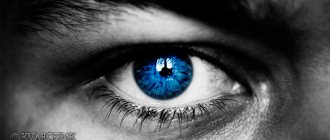In this article we will tell you:
- “Reading” a man’s gaze when meeting
- 14 types of a man's gaze when meeting
- The look of a man who should not be taken seriously when meeting
A man's look when meeting him can tell a lot about his intentions. It is generally accepted that representatives of the stronger sex are far from talkative. But even behind the feigned coldness, you can discern true emotions if you look into his eyes.
Do they glow with joy and warmth, or do they pierce with lifeless ice? Are there wrinkles in the corners of the eyes that speak much more eloquently than words about the funny character of your chosen one? In fact, the look of every man when we meet tells what is hidden in the most intimate corners of his soul. You just need to learn to “read” it correctly.
View direction
The look of a man in love expresses interest. Since the guy is focused on his passion, from those around him, first of all, he singles her out: he searches with his eyes, tries to catch her eye. When their gazes intersect, his further actions can develop according to the following scenario: he will either stare intently and uninterruptedly, as if spellbound, into the girl’s eyes, or, embarrassed, will look away to the side. The reaction will depend on his temperament, character, the circumstances in which the meeting took place, on how the lady of his heart treats him.
Determined, self-confident young people, not accustomed to giving in to difficulties, express with their gaze their determination and desire to win a partner. They have nothing to hide. They openly look ahead, boldly declaring, through various non-verbal signals, the firmness of their intentions to a potential partner and others.
If a guy looks at you in fits and starts, he is either quite shy and modest, or has not yet understood exactly what feelings he has for the girl. It may well happen that at the beginning of a relationship he will try to figure himself out, rather than send signals of sympathy.
It should also be taken into account that under the influence of love fluids, a guy’s behavior and his character can change radically. The buffoon and soul of the party can become a secretive and withdrawn modesty, preferring solitary leisure. It is possible that he will avoid direct visual contact with the girl. And a guy who is not very sociable will suddenly begin to amaze everyone with his wit, broad outlook and intelligence. Feelings will become a test of strength for him. And, having accepted this challenge of fate, from a shy young man he will turn into a leader and ringleader. Then, wanting to attract the attention of the girl he likes, he will cast scorching, piercing glances in her direction.
Being in the same company with his beloved, the first thing a man does is monitor her reaction to the story or news being discussed. If he looks at her face after he has spoken, this is a clear sign of sympathy.
Not wanting to give himself away ahead of time, the man studies his girlfriend to determine how she feels about him and whether she is ready to accept his advances. He admires his beloved: her movements, appearance, gestures, smile, and enjoys communicating with a special person for him.
Smiling while gazing
A man says he misses a woman - what does that mean?
A smile together with a gaze is a man’s weapon designed to melt women’s hearts. If a guy looks at a girl for a long time, when she sees this, smiles and looks away, this is a clear sign that the man is experiencing sexual attraction.
Looking eye to eye and a good-natured smile are signs of interest and curiosity. A man wants to meet his chosen one or start a closer relationship.
Point-blank eye contact and a slightly mocking smile indicate rather the opposite reaction. The girl is not interesting to him; such measures indicate irritability or even boredom.
Smile and look
Duration of eye contact
The sphere of love relationships is an endless subject of study by many specialists. Harvard University psychologist Zeke Rubin has made many developments in the field of research on this feeling. He and his supporters argue that eye contact is an important component of interpersonal interaction. By looking into the face of your interlocutor, you can accurately determine his emotions and thoughts associated with them. One of the psychologist’s well-known developments is called “Rubin gradation.” This scientific method allows you to calculate a person’s falling in love by the amount of time spent on the object of contemplation.
Eye contact between people communicating usually accounts for approximately 40-50% of the total dialogue time. If the numbers increase by an order of magnitude and reach 70-85%, this indicates that Cupid has intervened in the relationship.
At the moment of the first conversation with the object of passion, the man’s attention is so concentrated on the woman that he can easily describe her hairstyle, demeanor, timbre of voice and her outfit.
Scientists have come to the conclusion that if a man stares at a woman for more than 10 seconds, most likely he experiences not just sympathy, but falling in love. A shorter glance towards a woman indicates a lack of interest in her.
Do you want to check if your object of desire is in love with you? Count how long he doesn't take his eyes off you during the conversation.
Why does a man look into your eyes without looking away?
© Getty Images Pro
He finds you attractive.
If you notice that he mostly looks at you and there is no obvious reason to dislike you, then he most likely finds you very attractive.
In this case, there will likely be other signs and gestures that indicate his sympathy, such as:
- His pupils dilate when he looks at you
- His feet are pointed in your direction, even if you are not in close proximity.
- Trying to get closer to you
- Adjusts clothes or hair when he sees you
- Asks his friends about you
- Quickly turns away and smiles when you notice him
- Feels nervous when other men are around you
- Laughs and looks at you to see if you are laughing too.
- Stands next to you when talking
- Speaks in a lower voice
- Blinks more often when talking to you
- Touches you more often
- Maintains eye contact with you longer than usual
- No negative cues such as squinting eyes, tense jaw, or crossed arms
Wants to know if you like him.
It's also possible that he finds you attractive but isn't sure if you like him.
This is the reason why he may look at you so much in an attempt to find out what you think about him.
If this is indeed the case, pay attention to the signals mentioned above.
Pupil size
Physiologists say that love is a chemical reaction. They explain the emotional uplift that a person experiences when falling in love with the production of norepinephrine, dopamine, adrenaline and oxytocin. This cocktail turns on the same buttons as drugs, so it seems to us that we are floating above the earth and feel absolutely happy.
How can you tell by looking that a man is in love? It turns out that the process of arousal causes the pupils to dilate. Moreover, it does not matter what exactly provoked it - the sight of a beloved or a meeting with a robber in a dark alley. Our parasympathetic nervous system does not care what became the reason for the change in the usual psycho-emotional state. The pupil will reflexively enlarge in any case.
Back in the 70s, psychologists White and Maltzman conducted a number of experiments in this direction. The subjects were given excerpts from three books to listen to: erotic, neutral, and containing scenes of cruelty and violence. It was found that at the beginning, the pupils of all subjects dilated, expressing their interest in the new information, but in the further course of the experiment, such a reaction was observed to the first and third books. Psychologist Bernik also came to a similar conclusion, claiming that men and women’s pupils dilate when they are sexually aroused.
This feature of the human body was used by our great-grandmothers from several generations, who wanted to attract the attention of the gentleman they liked. To dilate the pupils, thereby informing the object of love about arousal, they ate a small amount of poison - belladonna tincture. It’s good that in our time, progress allows us to solve this problem in a less radical way. For example, in Asia, the female half of the population now wears colored lenses with dilated pupils.
Confirmation that people find pool eyes very attractive is the active use of this fact for advertising purposes. Often on posters and packaging of cosmetics you can see images of models with dilated pupils. Marketers claim that such a move increases sales levels significantly.
How to respond to a man's loving gaze
If you like a man and want to start a long-term relationship with him, respond to his gaze with long eye contact.
Be sure to smile at your interlocutor: he will understand that he is pleasant to you and does not push you away. The smile should be light, sincere, but not on duty.
Play with your eyes: look first into the eyes, then look away to the side and return to the face of your chosen one. Offer to drink coffee in a nearby cafe, listen carefully to the man, ask more questions regarding his life and work.
What is the look of a man who is in love?
A representative of the stronger sex in love is so focused on the girl that at the moment of communicating with her he can “fall out” from the surrounding reality. He does not pay attention to the city noise, cars passing by, becomes a little absent-minded, but at the same time he is able to reproduce in detail all the information that she tells him. He looks carefully, listens and tries to remember everything, even if he is absolutely not interested in the topic being discussed.
What is the look of a man in love? Shining, sparkling with joy and positivity, gentle, affectionate, warm, friendly, caring. He sees the treasure before him and enjoys the charm and beauty.
His pupils are dilated, his eyebrows are slightly raised, as if he is asking: “I love. How do you feel? From time to time, a mischievous, playful light flashes in the eyes. He does not always manage to restrain the “pressure” of his gaze, to control its power. Therefore, sparks are sometimes very bright, turning into flames. They say about this look: “I would eat it with my eyes.” After all, among males, love is inextricably linked with physical desire and attraction. This explains the fact that during flirting his gaze can be flirtatious and intimate.
A flirting look is difficult to confuse with any other. It is intermittent, flirty, intriguing, promising, charming, sparkling, alluring.
An intimate look indicates sexual interest. He is slow, sliding through erogenous zones, assessing, undressing. This look lingers on the bare parts of the body and speaks more clearly than words about the man’s passionate desire.
An important element of non-verbal expression of feelings is the game of eyebrows. Fixed eyebrows indicate a lack of interest. Elevated ones convey a wide range of emotions: surprise, amazement, delight, admiration, and the desire to attract attention. Such eyebrows make the look more open, as if they “open” the eyes in order to reduce the distance between the interlocutors.
The key to many questions is a man's smile. It is believed that when a person falls in love, he experiences a feeling close to euphoria. It embraces the lover when the object of love appears. A wide, open smile is a mandatory attribute of sympathy.
The emotions in the gaze and smile should be identical. Dissonance may indicate insincerity. You should pay attention to the symmetry of the smile and the facial wrinkles that appear around it. An uneven, slightly slanted smile is a bad sign.
Is it true that the look of a person in love changes?
A man in love becomes straight in his gaze and lingers on the woman longer than usual.
When we fall in love, a powerful hormonal surge occurs in the body. We try with all our might and means to interest the object of our adoration, to capture his attention, thoughts, body, we want to spend every minute next to him. Seeking reciprocity, people in love change their appearance, go on a diet, go to the gym, and take up new hobbies.
At the same time, they observe their passion, note her reaction to her actions. A guy in love directs his gaze towards the girl, watches how she communicates with colleagues/friends, moves, laughs, dances, how her appearance, clothes or manners have changed.
A man in love becomes straight in his gaze, lingers on the woman longer than usual, his eyes seem to shine, “sparkles” flicker in them.
Sight.
Not good.
I can see in my eyes there will be war! Eye to eye, point blank. The mood is decisive, a challenge to an argument, a conflict is possible, a threat or an ultimatum is possible. The person is proud, dominant and treats you as a subordinate. Perhaps you are perceived as an outsider or you have broken some rules and they have the right to put you in your place. If, with such a look, a person restrained himself in public, then he will express his opinion or even resort to action afterwards. Therefore, if you do not want conflict, try to build bridges, establish good contact, noticing a belligerent attitude against yourself. It can also mean that you are being tested for strength. They are trying to subjugate you to your will, bend you to other stereotypes and show who is in charge here. This happens when talking with superiors, law enforcement agencies and a lawbreaker. If you show courage, determination and openness of intentions, then you will notice that people will look at you kinder. If you respond with the same stern and decisive look, then you have decided to accept the challenge.
Friend.
I can see it in your eyes, friend!
A businesslike look, open to new information. The interlocutor has nothing to hide and is attentive to your sincerity. Intuitively seeks your open response gaze as a reason to continue to be open. Especially during an interview, honest workers look at the boss like this during a casting. With their open gaze they want to show their honesty and want to catch the kind glance of their boss, they want to see his approval.
Respect.
I can see it in his eyes - he respects!!! A glance at the lips speaks of lively communication and a friendly attitude. Perhaps deep respect, that is, a person hangs on every word. This is often seen during a conversation between a boss and a subordinate, who, by the way, have good human relations. The subordinate tries to catch the word of the boss in order to complete the work more accurately, do something pleasant and maintain good relations. This can be seen when a real authority says something, tries to convey it to the audience, and the listeners gratefully and devotedly receive the instructions.
Sympathy.
I can see it in your eyes - I like you! From eye level and below to the chest and below. This often indicates intimate interest and affection. Men are more open about such views. A person reveals his cards often intuitively and experiences embarrassment when his gaze is intercepted and exposed. They often say in the eyes I can see who likes whom and this is often to the point. In a family, such a look serves as a hint of a desire for intimacy, which is legal. However, between people who are not legally married, this is perceived as flirting and can lead to real problems and misunderstandings.
Fear.
I can see it in his eyes - he’s afraid. A look that avoids meeting. An attitude of humility, submission, fear. Views of subordinates in relation to superiors. This fear is not panic, but constant, established and accepted. It can be feigned in order to mislead and to milk one’s goals through false humility. However, they are often afraid of those who really have leverage and with whom it is better not to argue.
Attention.
I can see in his eyes that he is completely attentive. The upper eyelids are raised, the gaze is straight - “googling”. This means increased attention to your person. It remains to understand this attention negatively or positively. Look at facial expressions and gestures, listen to words and hints, look at the pupils. If the attention is positive, it means that the person is simply fascinated by you, fascinated, admired by you. Ready to imitate. If the attention is negative, then the person seems to be trying to open his eyes wider to accommodate more information about you, so that later he can use it against you. Again, through other manipulations, he can hide his motives. Be careful.
Wish.
I can see in his eyes what he wants from me. The gaze is frequent, almost demanding, often intent. It becomes clear that the person wants to say, show or convey something and is trying to establish eye contact. A possible variant of imitation with this view is that a person tries to study behavior in advance or for other reasons. Such a person catches your gestures, facial expressions and tries to draw conclusions for himself. This is easy to notice when in a crowd one person tries to attract the attention of someone; when one, with a large number of eye contacts, constantly looks at someone, is distracted from the immediate interlocutors. It may be trying to read you and can't do it fast enough.
Interest.
I see interest in his eyes. This is an obvious wink, raising an eyebrow, eyebrows. The person is trying to agree with you on something, to be on the same team with you, on the same wavelength, in the same connection, etc. He expresses sympathy and even some intimacy in your relationship. He wants to show that you and him are for one thing, unlike others, that you have your own secret. However, in some cultures, winking is not accepted and is perceived as disrespect, an insult to dignity and leads to resentment.
Smile.
I can see it in his eyes - he is smiling. Look into the eyes, eyebrows raised slightly defiantly, the corners of the eyes slightly raised. It remains to understand what kind of smile this is - for good or not. Everyone knows the conclusions and evidence of scientists on how to distinguish a real smile from a fake one. With a fake, fake, fake smile, the corners of the mouth rise, and with a real smile, the outer corners of the eyes also rise. This was also noted by the French neuroanatomist Duchenne de Bologne in the mid-19th century. If a person is able to regulate the muscles of the mouth consciously, then the muscles of the eyes act instinctively, according to the orders of reactions in the brain and therefore cannot be done. Therefore, you see laughing eyes, and not just a smile on the mouth, then this is sincere and for good. But if only the mouth smiles and the eyes are “silent,” then the person is insincere and often professionals of deception mislead with such a smile with their friendliness, having purely mercantile goals. Or a person laughs through tears, he has no time to laugh at all, but on the contrary, he needs help.
Surprise.
I can see it in your eyes - surprise! The eyes are wide open, most of the white of the eye is visible; the eyebrows are drawn apart and moved apart; mouth slightly open. When a person is surprised in a positive sense and taken aback in a negative sense, facial expressions and gestures for at least a few seconds will show everything. At the emotional level, the one who was exposed will show indignation; his eyes will not show any positivity. And vice versa, if a person finds the surprise pleasant, his gaze reaction and facial expressions will be positive, perhaps feigned, but positive.
Shock.
I can see it in his eyes - he’s shocked. Eyes are raised up to the ceiling or sky.
Shock and surprise are different emotional states. And it is also expressed in different ways. Remember your facial expressions when shocked and surprised!? When a person is shocked by unexpected news, positive or negative, he seems to be looking for an answer from above why this happened or thanking someone on high for a blessing. A person may raise his hands up, clench his fists out of frustration, resentment, or vice versa out of joy and delight. Gestures are broad and sweeping. Speech is loud. Negative shock is visible when hearing the news of someone’s death, about an accident with someone, about being fired from a job, about a sudden diagnosis. A positive shock at the news of a long-awaited fulfillment of a desire, when entering a job, to study, when unexpected help appears in a seeming dead end.
Fright.
I can see it in my eyes - I’m scared! The gaze is open, as if in surprise, but the eyelids are tense in anticipation of danger; the eyebrows are raised, but knitted together, the lips are narrow, compressed like stripes. The gaze may be fixed and fixed because the person may be trying to catch changes in the offender's mood. By other objective signs, fear is easy to recognize if it is not hidden. A person trembles, shrinks, goes into the shadows, his hands become cold, etc. If a person tries to hide fear, then one can understand fear by the tense eyes that literally do not look away from the source of aggression. This often happens when, during a conversation with a couple, something unpleasant for them comes up and at this moment he or she intensely and incessantly looks and listens to what the other is saying. The one being looked at apparently has a strong opinion on this matter and the other has been subjected to verbal or physical violence more than once when disagreeing. Also, children in the campaign are guided by the aggressor when it comes to moments that were already acute, but which children are trying to hide from their parents.
Hatred.
I can see it in his eyes - he hates him. The eyes are squinted, narrowed and almost invisible; gaze point blank, without blinking, eyelids tense. They want to intimidate you and perhaps the threat is real. The eyes don’t lie and it’s better to resolve this situation quickly. This is what tyrant bosses and aggressors often do.
Doubts.
I see it in my eyes - I doubt it. The eyes are narrowed or, on the contrary, slightly open and directed at an indefinite point, the eyebrows are slightly frowned or, on the contrary, parted but slightly, as if from the surprise of a situation of choice for which he is not prepared. Facial expressions: a person can scratch the back of his head, close his hands, closing himself off to make a difficult decision for him, and there will be a slight sweating from excitement. This often happens when a person is pointed out to a contradiction in his words and he tries to create logic in his judgments; when there is no trust between the interlocutors and the conversation is serious and therefore has serious consequences. Also when a person is offered responsibility for which he is not ready. For example, if a girl or guy is not ready for marriage, but receives an offer, then this is the reaction. Or when a young man finds out that he will become a father, he is often confused and looks into nowhere, trying, of course, not to show this to others.
Embarrassment.
I can see it in his eyes that he is embarrassed. The upper eyelid is slightly lowered, covering the eyeball, a secret glance, short-lived and imperceptible; head down. This is a sign of emotional submission, although pleasant for the subordinate. This can be seen in a conversation between a teacher and a student on good terms. The student is even embarrassed to look at the teacher out of great respect. These eyes are sometimes used to perceive a woman's flirting. A woman does not openly view the subject of interest like a man, but rather hides it and behaves like a child. If at school a male teacher gives advice to a female student, it is precisely because of the gender difference, and not out of respect, that the female student does not look the teacher directly in the eye.
Shame.
I can see it in your eyes - shame on you, traitor! The gaze avoids the oncoming person, often at the feet, at other objects, the eyebrows are slightly frowned in order to hide the gaze, redness of the face, constrained movements, the person ignores the topic and questions that are uncomfortable for him. A striking example is delinquent children. Without literal evidence, just one glance, the parent understands that the child has done something wrong. This can be seen when the spouse tries to hide the betrayal, and the other sees everything in his eyes. The spouse has no evidence, but sees that the look is treacherous, not open, fearful and, well, bashful. Shame and guilt at least somehow show regret about what they have done and provide a reason for the innocent party to soften up. This can be seen with the betrayal of a friend and the unpleasant realization of this, with forced communication, although intrigues are being built behind one’s back. In business matters, people are often asked to look people in the eye, and betrayal is clearly visible.
Not guilty.
I can see it in his eyes - he’s innocent! The gaze is direct, unwavering, the eyes are open wide, the eyelids are strained from trying to prove his innocence. The person is trying to discern whether they believe him or not and therefore looks steadily and appraisingly. Gestures are open, palms inside out, shoulders straightened. The tone of his voice is raised out of a desire to hear his evidence of innocence. All movements are aimed at the one to whom they want to prove innocence. Although scenes of jealousy are often hidden from the eyes of strangers, there are situations when the husband publicly tries to prove to his wife that he did not look at anyone but her. The husband spreads his hands, looks broadly at his wife and speaks loudly about his love for her. Perhaps he did something reprehensible in fact, but obviously not on purpose. Or when the husband asks about the money spent, the wife, looking wide, wants to show that she does not understand where the money goes. Most likely, she doesn’t know how to save, but she doesn’t do it on purpose. There are, again, skilled deceivers who will convince you of their innocence even when caught in the act of a crime. Be careful.
Excitement.
I can see it in his eyes - he’s worried! Here we note frequent blinking as the main sign. A darting look, asking for help. Movements are nervous, palms may become sweaty, and cannot sit still. It remains to find out the cause of the excitement. Again, positive or negative. If in front of you is a deceiver, an enemy, then he is trying to hide his eyes from you by blinking frequently, trying to avoid meeting gazes so that you do not read his eyes. This is especially pronounced when a loved one has plans against you and is worried because you know him too well. Before cheating, the spouse may worry and not find a place for himself. Of course, this can be well veiled. Positive excitement is often a anticipation of something very good, long-awaited, good news. For example, pre-wedding preparations are pure excitement! Finding out what gender the child will be is a real excitement for some. A man who is waiting for a girl’s response to his marriage proposal is worried and finds no place for himself. Men in love often blink when looking at their beloved.
A man wants a woman: signs
The desire to get closer physically speaks of a caring attitude towards a woman. A man wants a woman - he likes her.
- Lustful look. He looks at the décolleté, hips, and studies the woman’s form. The gaze wanders over the body.
- Unambiguous hints. Hints at sex, comes from afar.
- Flat jokes. Makes vulgar jokes that hint at desire.
- Invitation to visit. Invites you to a cafe/cinema/restaurant/home with an unambiguous hint to continue the evening. When refused, aggression occurs.
Physical attraction gives rise to fantasies in a young man. The coincidence of fantasies and reality is the key to the success of a relationship. Men can truly fall in love after the first intimacy. His expectations were not met - he would not get to know the woman any closer.
What do a person's eyes say?
Some people tend to fib a little when answering questions about age. According to a study conducted by Tobias Lautcher and his colleagues from the University of Melnburg, our eyes reveal what number we are currently thinking about. According to Lautcher, there is a complex relationship between abstract thoughts and the movements of our body .
Forty participants in the experiment were asked to think about a randomly selected number from 1 to 30. Using an eye-tracking device, the scientists tracked the direction of gaze and how the position of the pupils changed depending on the change in number. Results:
- If the next number was less than the previous one, then the gaze moved down to the left.
- If the number was higher, then up to the right.
The direction of gaze tells not only whether a larger or smaller number was intended (based on the speed of movement of the gaze: the larger the number, the more intense the movement), but also what number we are talking about. Although, it is quite difficult to see the difference with the naked eye.
Scientists explain this reaction as follows: we imagine an imaginary number series, where the numbers are arranged from left to right in ascending order. At the same time, we mentally, at the subconscious level, move our gaze along this row, depending on what number we are thinking about. It is worth clarifying that this statement only applies to representatives of Western cultures. In cultures where they write and read from right to left, everything will be the other way around.
Eyes as part of self-knowledge: the power of the gaze
Look into my eyes and I will tell you a lot about you... In fact, you can learn a lot about a person by the play of your eyes and visual contact. Here are some examples:
- The one who talks blinks more often than the one who is silent. If the opposite happens, then the interlocutor is most likely bored.
- Frequent blinking, which is so characteristic of women, does not signal her desire to please a man, as is commonly believed, but is a gesture of submission.
- A close, intense gaze, on the contrary, will signal the strength and charisma of the beholder. Actor Michael Caine must have trained for years to achieve this look.
Staring closely can confuse your interlocutor. An inquisitive look will cause uncertainty in the interlocutor. Many businessmen test each other with their gaze at the first meeting: whoever looks away first loses. After this, it becomes clear who has weaker nerves (or who has something to hide).
But the principle applies here too: only the dose makes the medicine poison. Psychologists from the University of Freiburg came to the following conclusion: staring will lead a person to the desire to resist possible influence. We can say that such a look makes a person stubborn and unyielding. Direct, continuous eye contact will awaken in a skeptical interlocutor the desire to contradict or completely reject the opponent’s opinion.
The fact that most people cannot maintain prolonged eye contact is supported by research conducted in 1977 by Donald Elman of Kent State University. The scientists chose an intersection with a traffic light for the experiment. At the same time, they looked closely at the drivers when the light turned red. As a result of the study, the following conclusions were drawn: drivers who experienced this look started faster when the light turned green. However, a smile could neutralize the driver's reflex to escape.
The eyes as a part of self-knowledge manifests itself even in these cases, because by tracking your own gaze, you can monitor your behavior. Reveal the hidden traits of your character and delve into the root of their occurrence, isolating the most important thing, what forms the basis of your personality, your uniqueness.
Psychology of gaze: interesting facts
1. Women prefer open-eyed men
for long-term relationships. A half-open look is perceived as an attempt to have an affair, rather than a serious relationship.
2. Blinking frequently
is perceived as a sign of a person’s nervousness. Presidential candidates who blinked frequently were more likely to lose elections.
3. It used to be believed that a shifting gaze
betrays the deceiver. However, this opinion has been refuted, as it is believed that a person looks left and right when thinking about what to say. Moreover, one must suspect a person whose gaze never wavers. Professional liars are very good at pretending to look impartial. They try to make eye contact more often because they know we are looking for signs of deception.
4. One of the first signs of sympathy is dilated pupils.
. Advertisers know this and often enlarge the pupils in photos in Photoshop.
5. Squinting or narrowing of the eyes
means suspicion or mistrust. People often don't realize how they do this, so you can use this information to remove doubt.
6. People raise their eyebrows
when they want to be understood correctly. This signals intimacy and a desire to establish contact.
7. Looking to the side
may be a sign of insecurity, but if the person raises an eyebrow at this, they have a romantic interest in you.
8. darting gaze
indicates a feeling of insecurity; a person is looking for ways to get out of an awkward situation.
9. When we're angry, we avoid eye contact.
: “I can’t even look at you right now.”
10. Wealthy or high status people are more likely to be distracted and make less eye contact. By turning away during a conversation with the interlocutor, they demonstrate their superiority.
11. Women raise their eyebrows and slightly close their eyelids
to give your gaze an exciting look, like during an orgasm.
12. When a woman looks up and then away
- This is an inviting gesture aimed at the man you like.
13. Researchers have found that men often miss women's first eye signals during courtship. On average, a woman needs to do this three times for a man to notice.
.
You're just suspicious
“My professional opinion is clear: a person is not able to feel the gaze of other people,” says clinical psychologist Ivan Alimenko. —Due to his fantasies, he can only assume that someone is looking at him.
According to him, it is possible to identify certain types of character that suggest a tendency towards such fantasies. This includes people with an anxious and suspicious character (for them there is a lot of anxiety in the air), people who lack attention (they unconsciously want to be looked at).
The psychologist emphasizes: the belief that you can feel eyes on your back is a sign of mental pathology.
What does a man's gaze tell you?
You can tell a lot about a man's intentions by looking into his eyes.
Are they alive or lifeless, cold or warm? Do wrinkles appear around the eyes when he smiles and laughs?
If you think about it, every man you date says everything he needs to say with a look, without saying a word.
And while it's almost impossible to know exactly what's going on in another person's head, you can read a lot from their body language. What does a man's gaze mean?











